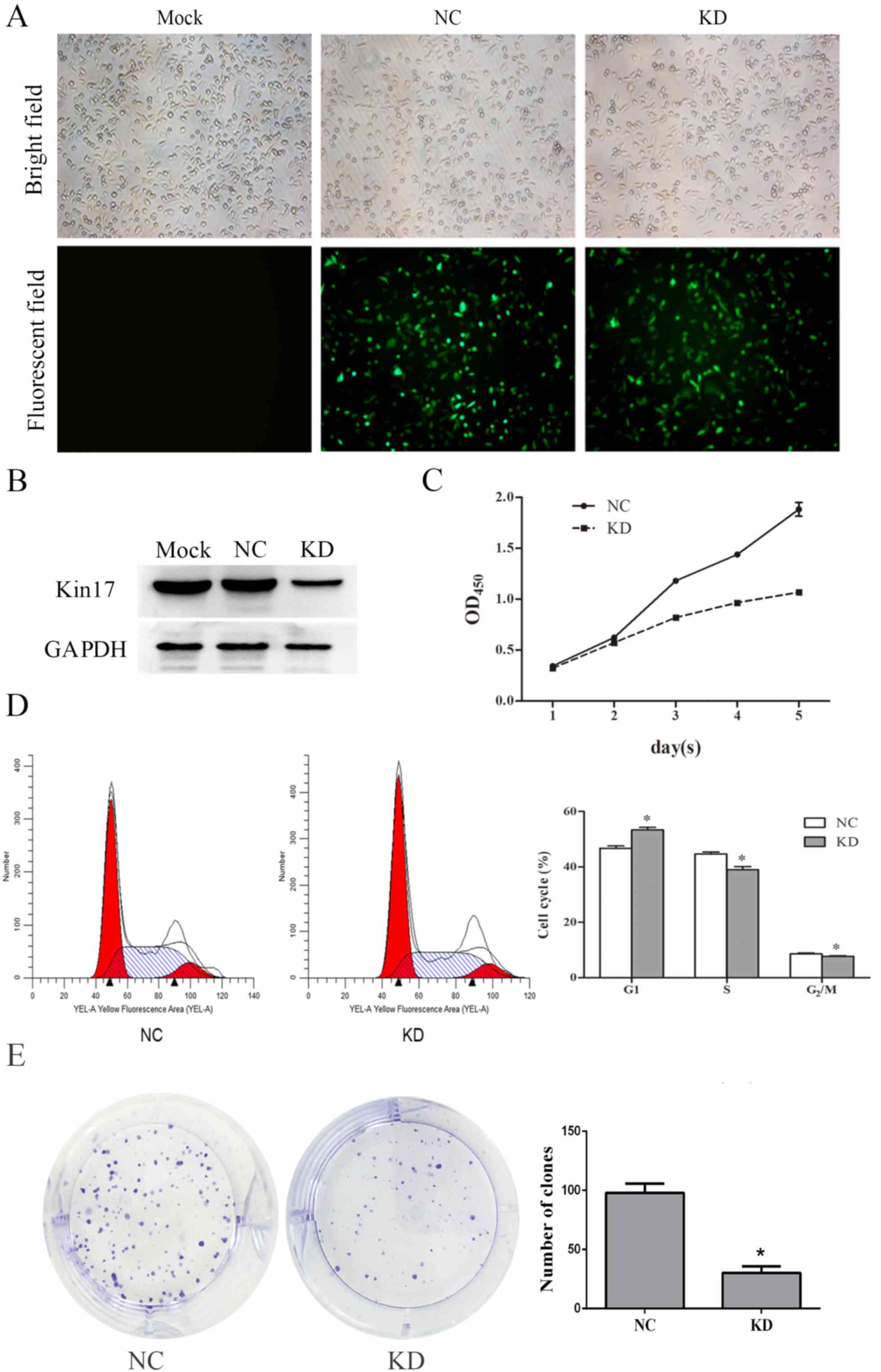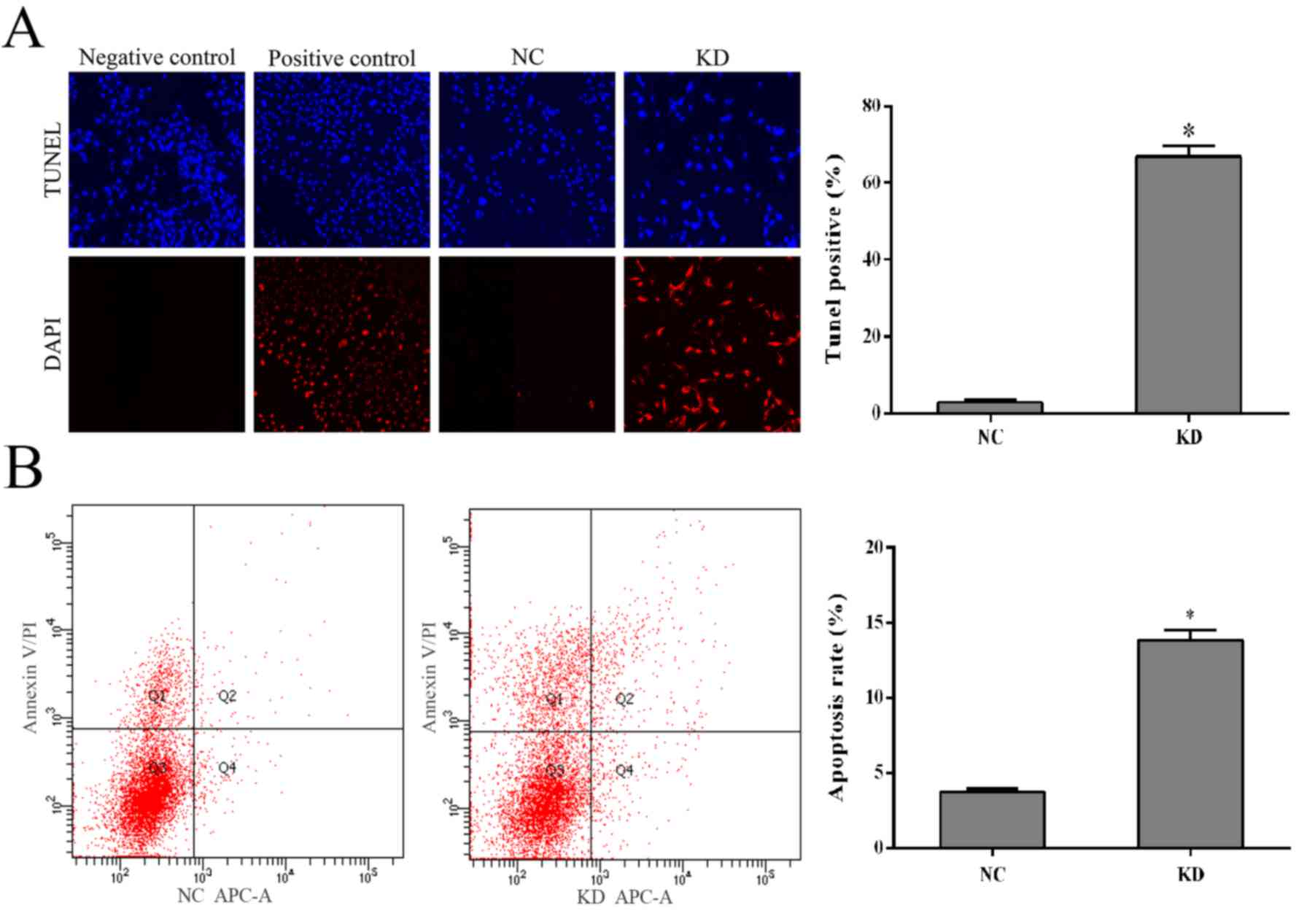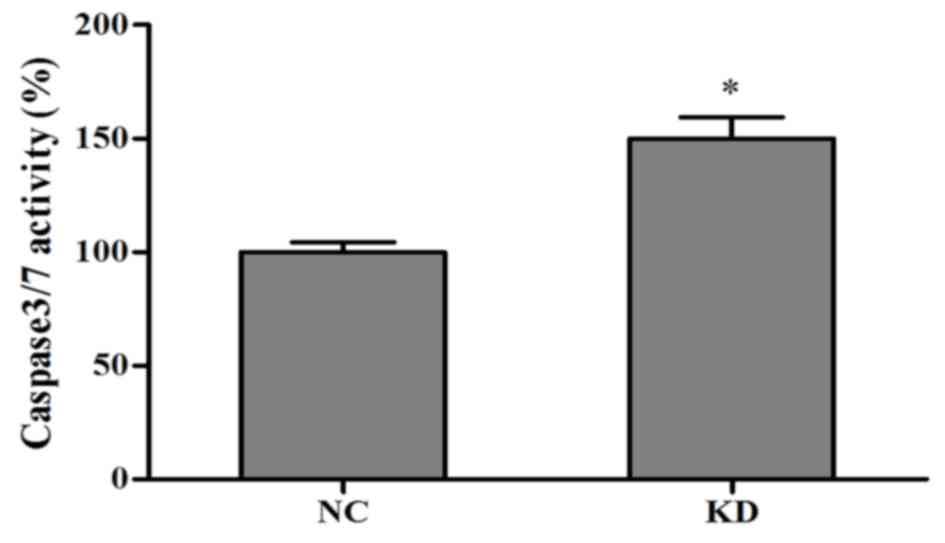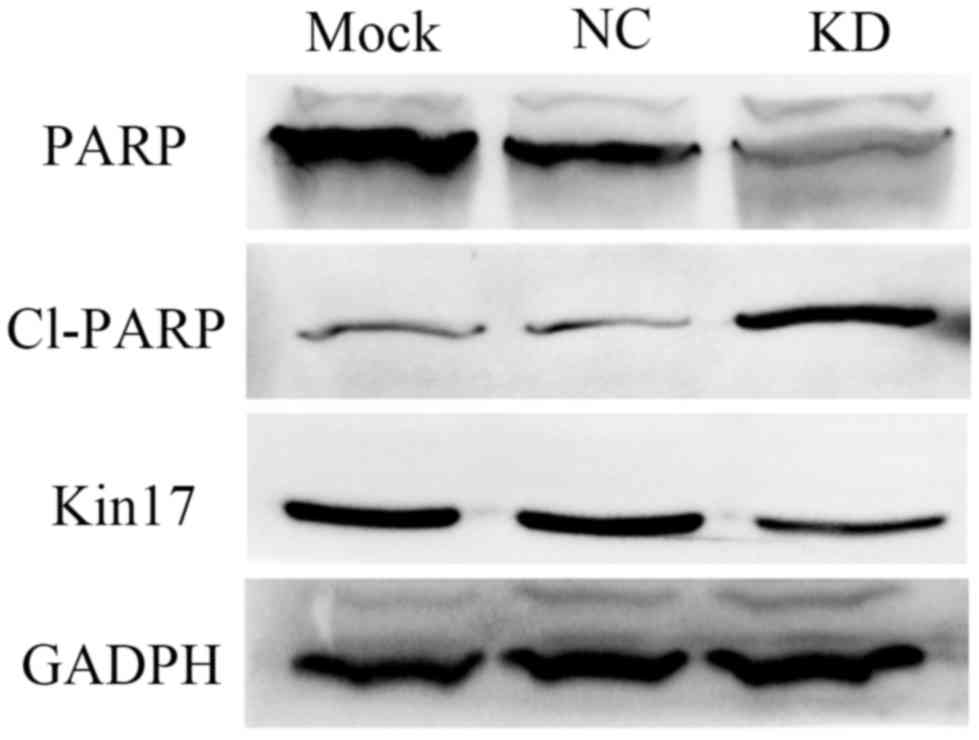Knockdown of DNA/RNA‑binding protein KIN17 promotes apoptosis of triple‑negative breast cancer cells
- Authors:
- Published online on: October 18, 2018 https://doi.org/10.3892/ol.2018.9597
- Pages: 288-293
-
Copyright: © Gao et al. This is an open access article distributed under the terms of Creative Commons Attribution License.
Abstract
Introduction
Breast cancer is the most common type of cancer and the second leading cause of cancer-related mortality in women globally (1). Although the mortality rates have recently decreased due to the advancement in detection techniques and treatment (2), the efficacy of available breast cancer therapies remain unsatisfactory. For instance, triple-negative breast cancer (TNBC) and drug resistance pose a therapeutic challenge. Currently, there are no specific targetsfor TNBC (3). Thus, investigation into novel biomarkers that can act as drug targets iscritical (4–6).
DNA/RNA-binding protein KIN17 (kin17) is a constitutively expressed protein in mammalian cells that is generally expressed at low levels in human tissues and organs (7). Studies have shown that kin17 is closely correlated with DNA replication, mRNA processing and cell cycle regulation (8,9). Kin17 was previously revealed to be upregulated in various tumors, including breast cancer, colorectal carcinoma, hepatocellular carcinoma and non-small cell lung cancer (10–13). Specifically, Zeng et al (10) demonstrated that kin17 is essential for the proliferation of breast cancer. Therefore, the present study aimed to comprehensively investigate the role of kin17 in breast cancer.
In the present study, the influence of kin17 knockdown in the proliferation and apoptosis of MDA-MB-231 cells, the representative cell line of TNBC which is negative for estrogen receptor (ER), progesterone receptor (PR) and human epidermal growth factor receptor 2 (HER2), was investigated.
Materials and methods
Cell culture and transfection
Human breast cancer MDA-MB-231 cells were purchased from the American Type Culture Collection (Manassas, VA, USA), and cultured in Dulbecco's modified Eagle's medium (Gibco; Thermo Fisher Scientific, Inc., Waltham, MA, USA) supplemented with 10% fetal bovine serum and 1% antibiotic cocktail (60 µg/ml penicillin and 100 µg/ml streptomycin). The cultures were maintained in 5% CO2 and 95% humidity at 37°C. Cells were seeded in 6-well plates ata density of 1×105 cells/well and transfected with lentiviral vector against kin17 (MDA-MB-231KD cells) or NC vector (MDA-MB-231NC cells) (Shanghai GeneChem Co., Ltd., Shanghai, China) using opti-MEM (Gibco; Thermo Fisher Scientific, Inc.) and polybrene (Shanghai GeneChem Co., Ltd., Shanghai, China) according to the manufacturer's protocol. The volume of lentiviral vector against kin17 and NC vector were 3.5 and 4.6 µl, respectively, which were calculated according to the manufacturer's formula and the concentration of polybrene was 5 µg/ml as recommended by the manufacturer. MDA-MB-231 cells without transfection with vector (Mock MDA-MB-231 cells) were used as a blank control. The transfected cells were cultured in the suspension supplemented with 1.5 ug/ml of puromycin on the pre-medium in 5% CO2 and 95% humidity at 37°C and the subsequent experiments were conducted when the cells containing the fluorescent vector reached 90% and the knockdown of kin17 was verified by western blot analysis prior to any other experiments.
Cytotoxicity assays
Cytotoxicity was measured in 96-well plates using a Cell Counting kit-8 (CCK-8) assay kit (Dojindo Molecular Technologies, Inc., Kumamoto, Japan) according to manufacturer's protocols. MDA-MB-231NC and MDA-MB-231KD cells were seeded at a density of 2,000 cells/well and allowed to grow for 24 h. Absorbance was measured at 450 nm using amicroplate reader (Thermo Fisher Scientific, Inc.) following incubation for 24, 48, 72, 96 and 120 h.
Clone formation test
The clone formation test was performed to measure cellproliferation. MDA-MB-231NC and MDA-MB-231KD cells were cultured in 6-well plates at a density of 200 cells/well for 2 weeks. Cell clones were immobilized with methanol and stained with crystal violet at room temperature for 15–20 min. Colonies containing >50 cells were counted using CKX41 Inverted MicroScope (OLYMPUS Corporation, Tokyo, Japan) at ×10 magnification and ImageQuant TL7.0 Image Analysis software was applied to image analysis (GE Healthcare Life Sciences, Little Chalfont, UK).
Flow cytometry
MDA-MB-231NC and MDA-MB-231KD cells were digested with EDTA-free trypsin and harvested by centrifugation at 400 × g for 5 min at room temperature. The collected cells were washed twice using PBS (Gibco; Thermo Fisher Scientific, Inc.). The final pellet was resuspended in binding buffer and stained with Annexin V-APC and propidium iodide (PI) (Shanghai GeneChem Co.) for 15 min in the dark at room temperature prior to the apoptosis analysis. For cell cycle analysis, the final pellet was fixed in 70% cold ethanol overnight at 4°C and treated with RNaseA for 30 min in a water bath at 37°C. PI staining was then performed according to the manufacturer's protocol. Flow cytometry analysis (BD LSRFortessa™; BD Biosciences, San Jose, CA, USA) was used forthe determination of the level of apoptosis and distribution of the cell cycle. The fluorescence lifetime, intensity and other optical data were collected from 10,000 cells using Annexin V-APC or PI for apoptosis and cell cycle analysis, respectively, using BD FACSDiva Software v8.0.1 (BD Biosciences).
TUNEL assay
TUNEL assay was performed using In Situ Cell Death Detection kit, TMR Red (Roche Applied Science, Penzberg, Germany) according to the manufacturer's protocol. Positive and negative controls were assessed in parallel, and the experiment was performed in triplicate. Briefly, cells were cultured in 96-well plates at a volume of 100 µl/well and fixed with 4% paraformaldehyde at pH7.4 at room temperature for 60 min. Cells were then permeabilized with 0.1% Triton X-100 in 0.1% sodium citrate (Sigma-Aldrich; Merck KGaA, Darmstadt, Germany). PBS was then used to wash the cells. For the experimental and positive control groups, the prepared cells were incubated with DNase I at room temperature for 10 min and 50 µl TUNEL reaction mixture was added following the incubation. The negative control group was treated with Label solution (50 µl) only, without incubation with DNase I. The cells were then incubated with the mixture in a humidified atmosphere for 60 min at 37°C in the dark. DAPI was added prior to the analysis with a fluorescence microscope. Three high-power fields were randomly evaluated from each sample at ×100 magnification.
Caspase 3/7 assay
MDA-MB-231KD and MDA-MB-231NC cells were harvested and resuspended in binding buffer. The suspension was added to 96-well plates in 100-µl volumes to give a concentration of 1×104 cells/well. Caspase-Glo® 3/7 assay (Promega Corporation, Madison, WI, USA) was later added to detect apoptotic cells according to the manufacturer's protocol. A blank control was set up in parallel to eliminate background interference. Absorbance was measured at 405 nm using amicroplate reader (Thermo Fisher Scientific, Inc.) following incubation for 2 h at 37°C. The activity of Caspase 3/7 in the MDA-MB-231KD group was calculated compared with the NC group, and therefore the mean value of NC group was always 100%.
Western blot analysis
Protein was extracted using Cell Total Protein Extraction kit (Nanjing KeyGen Biotech Co., Ltd., Nanjing, China). The MDA-MB-231KD, MDA-MB-231NC and mock MDA-MB-231 cells were digested by radioimmunoprecipitation lysis buffer on ice and then collected in Eppendorf tubes. The suspension was centrifuged at 20.8×103 × g at 4°C for 20 min to collect the supernatant. Protein concentration was determined by Bradford protein quantitation assay (Nanjing KeyGen Biotech Co., Ltd.), and 5XSDS was added to 0.25% volume of the collected supernatant. The mixture was heated in boiling water for 10 min. Following this, 50 µg protein from the MDA-MB-231KD and MDA-MB-231NC cells was loaded on to 12% SDS-PAGE gels. The separated proteins were transferred to polyvinylidene difluoride membranes (Merck KGaA) and blocked with 5% non-fat milk suspended in tris-buffered saline with 0.1% Tween-20 buffer at room temperature for 1 h. The samples were incubated with anti-kin17 (dilution, 1:500; cat. no. sc-32769; Santa Cruz Biotechnology, Inc., Dallas, TX, USA), anti-PARP (dilution, 1:1,000; cat. no. sc-8007; Santa Cruz Biotechnology, Inc.), anti-cleaved PARP (dilution, 1:1,000; cat no. #5625; Cell Signaling Technology, Inc., Danvers, MA, USA) and anti-GADPH (dilution, 1:500; cat no. sc-47778; Santa Cruz Biotechnology, Inc.) monoclonalprimary antibodies overnight at 4°C. Following the incubation, the samples were washed with PBS and incubated with horseradish peroxidase-conjugated secondary antibodies (donkey anti-mouse IgG, dilution, 1:2,000, cat. no. sc-2318; Santa Cruz Biotechnology and goat anti-rabbit IgG, dilution, 1:2,000, cat. no. #7074; Santa Curz Biotechnology) at room temperature for 1 h. Membranes were visualized withan enhanced chemiluminescence system (Fdbio Science, Hangzhou, China) and observed by QuantityOne v4.62 (Bio-Rad Laboratories, Inc., Hercules, CA, USA).
Statistical analysis
Data analysis was performed with GraphPad Prism v6.0 and SPSS v19.0. Data were presented as mean ± standard deviation. Continuity correction and Student's t test was used to assess variance among groups. All statistical tests and corresponding P-values reported were for two-sided tests, and P<0.05 was considered to indicate a statistically significant difference.
Results
Knockdown of kin17 reduces MDA-MB-231 cell proliferation
To investigate the role of kin17 in breast cancer, MDA-MB-231 cells were transfected with lentiviral vector against kin17 to knockdown its expression (Fig. 1A). Western blot assays confirmed that the protein levels of kin17 in the MDA-MB-231KD cells were markedly decreased compared with the levels in the MDA-MB-231NC and mock MDA-MB-231 cells (Fig. 1B).
CCK8 assay and cell cycle analysis were performed to assess the effects of kin17-knockdown on the proliferation of breast cancer cells. Notably, MDA-MB-231KD cell proliferation was significantly reduced compared with that of MDA-MB-231NC cells (P<0.05; Fig. 1C), indicating that kin17-knockdown altered the proliferation of breast cancer cells. Cell cycle analysis revealed that the ratios of cells in the S and G2/M phases were lower in the knockdown group compared with the NC group, while the percentage of G1 cells was higher in the knockdown group (Fig. 1D). The clone formation test was also performed to assess the effects of kin17 on proliferation, which revealed that the number of clones was significantly less in the knockdown group than in the NC group (P<0.05; Fig. 1E).
Knockdown of kin17 enhances apoptosis of MDA-MB-231 cells
To assess the role of kin17 in breast cancer cell apoptosis, endogenous kin17 was silenced in MDA-MB-231 cells with a lentivirus vector against kin17. The kin17-knockdown group revealed significantly higher apoptosis rates compared with the NC group (P<0.05) (Fig. 2A). TUNEL assay also indicated that kin17-knockdown enhanced apoptosis in the MDA-MB-231 cells compared with that in the control cells (P<0.05; Fig. 2B).
Caspase 3/7 may be involved in kin17-knockdown-induced apoptosis
Caspase 3/7 were detected following 3 days of culture. Notably, caspase activity was higher in the kin17-knockdown group than in the kin17 negative control group (P<0.05; Fig. 3).
Kin17-knockdown may induce apoptosis of MDA-MB-231 cells via poly (adenosine diphosphate-ribose) polymerase (PARP)
The effect of kin17-knockdown on expression levels of PARP and cleaved PARP in MDA-MB-231 cells was investigated. The expression levels of PARP were markedly decreased following kin17 knockdown, while the level of cleaved PARP was simultaneously increased compared with mock and negative control cells (Fig. 4).
Discussion
TNBC is a subtype of breast cancer that does not express ER, PR and HER2; it accounts for 15% of all breast cancer cases (14). Patients with TNBC always demonstrate higher rates of mortality and metastasis compared with other subtypes due to the absence of effective target therapies (15,16). Efforts to identify effective targets for TNBC have thus far yielded unsatisfactory results.
To investigate the potential targets for TNBC, the role of kin17 in a TNBC cell line was investigated. Kin17, a constitutive gene with extremely low expression in the majority of human tissues, has been reported to be markedly overexpressed in multiple tumors including breast cancer (10–13). In the present study, a lentiviral vector was used to stably knockdown kin17. Kin17-knockdown was revealed to significantly suppress the proliferation of MDA-MB-231 cells and prevent G1 to S phase transition, corroborating the findings of Zeng et al (10). Kin17 was also revealed to facilitate the apoptosis of MDA-MB-231 cells, as investigated with flow cytometry and TUNEL assays. Higher caspase 3/7 activity in the knockdown group compared with the NC group also suggested that caspase 3 and 7, which are wellknown toinduce cell apoptosis (17,18), may be involved in the kin17-mediated apoptosis of MDA-MB-231 cells. The underlying mechanism, however, requires further investigation.
Hormonal therapy has been considered as the first-line therapy for breast cancer since its emergence in 1973 (19,20). However, its applicationis limited, as only 20–30% of the patients exhibit a HER-2-positive subtype (21). PARPs are a family of enzymes that areinvolved in numerous processes, including DNA damage repair (22). PARP inhibitor, designed for germline breast cancer susceptibility protein-mutated TNBC, was revealed to be effective for the treatment of TNBC in a recent breast cancer trial (23,24). In the present study, the level of PARP was revealed to be significantly decreased by western blot analysis following knockdown of kin17, indicating that kin17 may enhance apoptosis of MDA-MB-231 cells by affecting the function of PARP. A previous study also reported that kin17 upregulation was significantly associated with p53 mutation and increased cyclin D1 and extracellular signal related kinase 1/2 expression in breast cancer cells, including TNBC cells (10). Thus, kin17 could become a novel target for the personalized treatment of TNBC and other breast cancer subtypes.
Frequent adverse events and the increasing risk of endometrial diseases, including endometrial cancer and endometrial polyps, have not only been observed in TNBC, but also in other types of breast cancer due to existing treatment methods (25,26). Development of targets for evaluation or treatment is necessary for the improvement of breast cancer therapy. Since it is unclear how kin17 alters proliferation and apoptosis of breast cancer cells, future investigations should focus on determining underlying mechanisms that could facilitate the use of kin17 a target for breast cancer.
Acknowledgements
Not applicable.
Funding
The present study was supported by the Guangdong Planning Project of Science and Technology (grant nos. 2014A020212190 and 2016A020215118), the Knowledge Innovation Program of Shenzhen Innovation Committee (grant no. JCYJ20160428101420063) and the Guangzhou Planning Project of Science and Technology (grant no. 201710010015). The funders had no role in the study design, data collection and analysis, manuscript preparation or decision to publish.
Availability of data and materials
The datasets used or analyzed during the current study are available from the corresponding author on reasonable request.
Authors' contributions
TZ, XG and KW conceived and designed the experiments. XG, YZ and MZ performed the experiments. XG, ZL and HW analyzed the data. XG and TZ wrote the paper.
Ethics approval and consent toparticipate
Not applicable.
Patient consent for publication
Not applicable.
Competing interests
The authors declare that they have no competing interests.
References
|
Siegel RL, Miller KD and Jemal A: Cancer Statistics, 2017. CA Cancer J Clin. 67:7–30. 2017. View Article : Google Scholar : PubMed/NCBI | |
|
Jensen MB, Ejlertsen B, Mouridsen HT and Christiansen P; Danish Breast Cancer Cooperative Group, . Improvements in breast cancer survival between 1995 and 2012 in Denmark: The importance of earlier diagnosis and adjuvant treatment. Acta Oncol. 2 Suppl 55:S24–S35. 2016. View Article : Google Scholar | |
|
Lukong KE: Understanding breast cancer – The long and winding road. BBA Clin. 7:64–77. 2017. View Article : Google Scholar : PubMed/NCBI | |
|
O'Reilly EA, Gubbins L, Sharma S, Tully R, Guang MH, Weiner-Gorzel K, McCaffrey J, Harrison M, Furlong F, Kell M and McCann A: The fate of chemoresistance in triple negative breast cancer (TNBC). BBA Clin. 3:257–275. 2015. View Article : Google Scholar : PubMed/NCBI | |
|
Miah S, Banks CA, Adams MK, Florens L, Lukong KE and Washburn MP: Advancement of mass spectrometry-based proteomics technologies to explore triple negative breast cancer. Mol Biosyst. 13:42–55. 2016. View Article : Google Scholar : PubMed/NCBI | |
|
Denkert C, Liedtke C, Tutt A and von Minckwitz G: Molecular alterations in triple-negative breast cancer-the road to new treatment strategies. Lancet. 389:2430–2442. 2017. View Article : Google Scholar : PubMed/NCBI | |
|
Kannouche P, Mauffrey P, Pinon-Lataillade G, Mattei MG, Sarasin A, Daya-Grosjean L and Angulo JF: Molecular cloning and characterization of the human KIN17 cDNA encoding a component of the UVC response that is conserved among metazoans. Carcinogenesis. 21:1701–1710. 2000. View Article : Google Scholar : PubMed/NCBI | |
|
Miccoli L, Frouin I, Novac O, Di Paola D, Harper F, Zannis-Hadjopoulos M, Maga G, Biard DS and Angulo JF: The human stress-activated protein kin17 belongs to the multiprotein DNA replication complex and associates in vivo with mammalian replication origins. Mol Cell Biol. 25:3814–3830. 2005. View Article : Google Scholar : PubMed/NCBI | |
|
Pinon-Lataillade G, Masson C, Bernardino-Sgherri J, Henriot V, Mauffrey P, Frobert Y, Araneda S and Angulo JF: KIN17 encodes an RNA-binding protein and is expressed during mouse spermatogenesis. J Cell Sci. 117:3691–3702. 2004. View Article : Google Scholar : PubMed/NCBI | |
|
Zeng T, Gao H, Yu P, He H, Ouyang X, Deng L and Zhang Y: Up-regulation of kin17 is essential for proliferation of breast cancer. Plos One. 6:e253432011. View Article : Google Scholar : PubMed/NCBI | |
|
Yu M, Zhang Z, Yu H, Xue C, Yuan K, Miao M and Shi H: KIN enhances stem cell-like properties to promote chemoresistance in colorectal carcinoma. Biochem Biophys Res Commun. 448:63–69. 2014. View Article : Google Scholar : PubMed/NCBI | |
|
Zhang Y, Huang S, Gao H, Wu K, Ouyang X, Zhu Z, Yu X and Zeng T: Upregulation of KIN17 is associated with non-small cell lung cancer invasiveness. Oncol Lett. 13:2274–2280. 2017. View Article : Google Scholar : PubMed/NCBI | |
|
Kou WZ, Xu SL, Wang Y, Wang LW, Wang L, Chai XY and Hua QL: Expression of Kin17 promotes the proliferation of hepatocellular carcinoma cells in vitro and in vivo. Oncol Lett. 8:1190–1194. 2014. View Article : Google Scholar : PubMed/NCBI | |
|
Hammond ME, Hayes DF, Dowsett M, Allred DC, Hagerty KL, Badve S, Fitzgibbons PL, Francis G, Goldstein NS, Hayes M, et al: American society of clinical oncology/college of american pathologists guideline recommendations for immunohistochemical testing of estrogen and progesterone receptors in breast cancer. Arch Pathol Lab Med. 134:907–922. 2010.PubMed/NCBI | |
|
Kohler BA, Sherman RL, Howlader N, Jemal A, Ryerson AB, Henry KA, Boscoe FP, Cronin KA, Lake A, Noone AM, et al: Annual report to the nation on the status of cancer, 1975-2011, featuring incidence of breast cancer subtypes by race/ethnicity, poverty, and state. J Natl Cancer Inst. 107:djv0482015. View Article : Google Scholar : PubMed/NCBI | |
|
Qiu J, Xue X, Hu C, Xu H, Kou D, Li R and Li M: Comparison of clinicopathological features and prognosis in triple-negative and non-triple negative breast cancer. J Cancer. 7:167–173. 2016. View Article : Google Scholar : PubMed/NCBI | |
|
Thornberry NA and Lazebnik Y: Caspases: Enemies within. Science. 281:1312–1316. 1998. View Article : Google Scholar : PubMed/NCBI | |
|
Earnshaw WC, Martins LM and Kaufmann SH: Mammalian caspases: Structure, activation, substrates, and functions during apoptosis. Annu Rev Biochem. 68:383–424. 1999. View Article : Google Scholar : PubMed/NCBI | |
|
Boccardo F and Rubagotti A: Switching to aromatase inhibitors in early breast cancer. Lancet. 369:533–535. 2007. View Article : Google Scholar : PubMed/NCBI | |
|
Mirkin S and Pickar JH: Selective estrogen receptor modulators (SERMs): A review of clinical data. Maturitas. 80:52–57. 2015. View Article : Google Scholar : PubMed/NCBI | |
|
Montero JC, Ocaña A, Abad M, Ortiz-Ruiz MJ, Pandiella A and Esparís-Ogando A: Expression of Erk5 in early stage breast cancer and association with disease free survival identifies this kinase as a potential therapeutic target. PLoS One. 4:e55652009. View Article : Google Scholar : PubMed/NCBI | |
|
Vyas S, Matic I, Uchima L, Rood J, Zaja R, Hay RT, Ahel I and Chang P: Family-wide analysis of poly(ADP-ribose) polymerase activity. Nat Commun. 5:44262014. View Article : Google Scholar : PubMed/NCBI | |
|
Lux MP, Janni W, Hartkopf AD, Nabieva N, Taran FA, Overkamp F, Kolberg HC, Hadji P, Tesch H, Ettl J, et al: Update breast cancer 2017-implementation of novel therapies. Geburtshilfe Frauenheilkd. 77:1281–1290. 2017. View Article : Google Scholar : PubMed/NCBI | |
|
Okuma HS and Yonemori K: BRCA gene mutations and poly(ADP-Ribose) polymerase inhibitors in triple-negative breast cancer. Adv Exp Med Biol. 1026:271–286. 2017. View Article : Google Scholar : PubMed/NCBI | |
|
Hamaoka S, Kitazawa N, Nara K, Sasaki A, Kamada A and Okabe T: Selective estrogen receptor modulator. US: pp. 469–476. 2011 | |
|
Jameera Begam A, Jubie S and Nanjan MJ: Estrogen receptor agonists/antagonists in breast cancer therapy: A critical review. Bioorg Chem. 71:257–274. 2017. View Article : Google Scholar : PubMed/NCBI |













